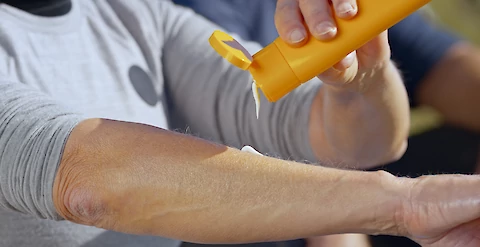
Senior Sun Protection 101: Senior Safety in the Sun
Sun protection is important at any age. According to the American Academy of Dermatology Association, one in five Americans will develop skin cancer in their lifetime. As you grow and age, your skin changes with you. It can become thinner, lost e elasticity and become more sensitive to the sun and other irritants.
There are many ways to protect yourself from overexposure to the sun’s ultraviolet (UV) radiation and sunburns. Below are the top three ways you can keep yourself and your loved ones protected.
Wear Protective Clothing
There are many factors that can play into how much protection your clothes can provide from UV radiation.
-
Wearing a wide brim hat with at least 3 inches can help to protect neck, ears, eyes, forehead, nose, and scalp. Tightly woven or knit hats can be more aeffective in comparison to loosely constructed straw hats.
-
Do not forget the sunglasses! Your eyes can be at just as much at risk to overexposure as the rest of your body. Make sure to check for a UV protection label as not to be fooled the color of their lenses.
-
Cover up with loose-fitting, long-sleeve shirts and pants. If the weather permits, opt for dark, long-sleeved clothing & pants for complete sun protection.
Sunscreen
Sunscreen is the most talked about form of sun protection and it is recommended by dermatologists to be worn every day. There are several options when it comes to sunscreen, but it can be helpful to start with the basics below.
-
The Skin Cancer Foundation recommends using sunscreen with an SPF of at least 15 every day.
-
Sunscreen should be applied 30 minutes prior to going outdoors and re-applied every 2 hours.
-
One ounce of sunscreen is recommended to be applied to the entire body for each application.
Limit Exposure
It can be easy to have an exciting time outdoors and forget to apply sun protection. Limiting your time in direct sun exposure can save you from a lot of hardship overall.
-
Avoid deliberate sunbathing and indoor tanning.
-
UV rays are most intense between 10 a.m. and 4 p.m. Staying in doors in shaded areas during this time of the day can make a dramatic difference.
-
Stay in the shade. You will not have to sacrifice the fresh air while staying in the shade with sunscreen and protective clothing.
Spending time outdoors and in the sun is key to maintaining your overall health. Staying protected against the harmful effects of UV rays does not mean that you cannot enjoy yourself outdoors.
At Senior Helpers, our care plans are customized to fit you and your loved ones needs as they change. Whether it is a reminder to re-apply sunscreen, a shopping trip to buy protective clothing, or 24/7 care, our caregivers our wide range of services ensures your loved one receives the care they both want and need. Contact us to learn more.